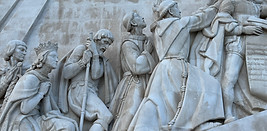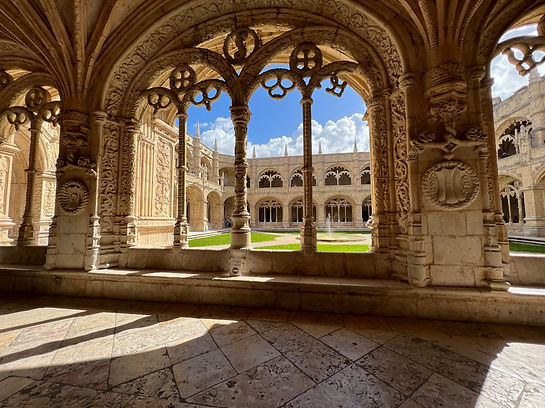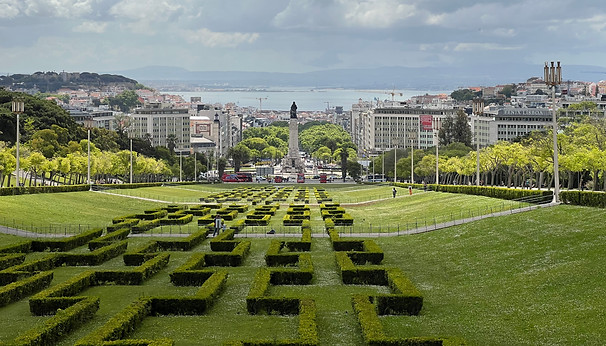
Belém
Day 3: April 27
This morning we were headed out to the burbs! The Belém district of Lisbon is about five miles west of Lisbon's city center. I guess that might qualify it as a suburb. There's a lot to do and see in Belém. Think of it as Lisbon's museum and monument district. Our bus was providing us with one-way transportation today. As a group, we'd be seeing and learning about the Belém Tower and the Monument to the Discoveries, then we'd be joined by a local guide, Ju, for a tour of the Jerónimos Monastery. This would be followed by time for lunch on our own, and finally we'd group back together for a guided tour of the Gulbankian Museum. When the museum tour was done, the rest of our afternoon and evening would be free time. On our own we could explore more of Belém or we could hop a train and head back into the city. A big day! I was excited for it!



There's Henry with his caravel, the light sailing ship that he developed that, unlike other ships of the time, could sail into the wind, permitting the Portuguese to explore the coast of Africa and other uncharted waters.
The pavement near the Belém Tower is a destination by itself! It's an exquisite mural, a huge compass mosaic in white, black, grey, amber and rose marble tile. Go to the center and you're standing on an Old World map showing the routes and dates of the Portuguese explorations. The ships of the Portuguese fleet are depicted on some of the tiles. From the ground it's amazing enough, but recognize that it's more than half a football field in size and look for a way to view this pavement from above to get the sumptuous full effect. (We didn't. When I later saw an image online, I really regretted that I had missed the overhead view in person.)
We started our time in Belém standing on the map and learning about the 15th Century Age of Discovery, and especially its central figure, Prince Henry the Navigator, the 4th son of King John I. Pay careful attention when you are first learning about Henry the Navigator, because you probably are going to hear his name a lot in Portugal! Whenever you see a statue of a historic figure wearing a hat and holding a model of a caravel, that's Henry.
Belém Tower

The Belém Tower might be the most famous landmark in Portugal. It was built in the early 16th Century as a fortress at the mouth of the Tagus River, to protect Lisbon from attack. The architecture is Manueline, our first introduction to this style that we would be seeing so much of throughout our time in Portugal, including later this morning at the Jerónimos Monastery. It is a unique, lavish Late Gothic style of architecture, indigenous to Portugal, developed during the reign of King Manuel I. (Hence the name that it was much later given.) It seems to have more to do with the decorative embellishment of a building than the physical design of the structure. Elaborate themed ornamentation is carved into the stone. This can include elements from the sea (e.g., shells, seaweed), botanicals (branches, leaves, acorns), icons of Christianity (crosses, saints, angels), maritime motifs (anchors, chains, ropes), and representations from newly discovered lands (exotic animals).



Monument to the Discoveries


One reason that we love to travel in Europe is that it's an opportunity to see sites that are so much older than anything we have in the U.S. The Monument to the Discoveries is not old. It was completed in 1960 to commemorate the 500th anniversary of the death of Henry the Navigator. Each figure on the monument depicts a real person with recognized importance in Portugal's history. They're holding props that help identify them. The monument was designed to look like the prow of a caravel, and Henry is at the bow, standing tall and proud. This is in contrast to the 32 others, each of whom is leaning upward, crouched with bent knees, to me symbolizing a deference to Henry as the leader in the building of Portugal's empire. The title of the monument might lead to the belief that all these people were explorers, cartographers, navigators, sea captains and others with maritime callings. The monument does include many such people. But there are also royals, two writers, two missionaries, a poet, a painter, a mathematician, and others. I understood the message: it takes a village to create an empire.



The wave-pattered pavement represents the sea. When we were first looking at the monument and learning about the people depicted on it, we were on the east side. It was easy to see all the details of the 16 figures because the sun was shining on them. The limestone was a pretty color in the sun. Then we walked around to the west side, which was in the shade, but the sun haloed Henry's head, giving him even more prominence than the monument already afforded him as he sailed into the back-lit clouds. This view included the 25th of April bridge in the background. A passing boat emphasized the grand size of the monument. A beautiful monument any way we looked at it!




Jerónimos Monastery

Standing outside of the Jenónimos Monestary, I set my phone's camera lens to the maximum wide angle view to snap a quick picture of the exterior but I still was able to capture only part of the facade. This place is enormous! The Rick Steves Portugal guidebook says there is a great view of it from the top of the Monument to the Discoveries, and you can get to that view platform using an elevator inside the monument. We didn't do that as a group activity, and during our free time in Belém, Gary and I didn't think to go back to the monument so that we could go up for the views. I'm regretting it because I also could have gotten that great overhead view of the marble compass mural. Maybe it's best we left some things unseen in Lisbon, as it adds more excuses to go back.
Jerónimos Monastery was built in the early 1500's near the embarkation point of Vasco da Gama's first voyage. The money to build it came from a tax on goods imported from Africa and Asia. You can tell how lucrative that trade was, because clearly no expense was spared in the construction of this building! When it was finished, the king placed the religious order of Hieronymite monks in the building, tasking them with the duties of praying for his soul and providing spiritual assistance to mariners who were on voyages to and from distant lands.
When we got to the monastery, we met up with Ju, a local guide for Belém. She gave us a fabulous tour of the two-story cloister, the refectory with its hand-painted tiled panels from the 1700's depicting scenes from the life of Joseph, and the church, with its beautiful carved stone columns and spiderweb-like ceiling. The church contains the stone tomb of Vasco da Gama (pictured below) and the tombs of the two kings he served. Jerónimos Monastery is one of the most prominent examples of Manueline architecture in Portugal. The lacy stonework is so beautiful!












Pastéis de Belém
Bakeries throughout Portugal sell flaky tartlets with a lightly spiced custard filling, called pastéis de nata. They're often sprinkled with powdered sugar. In English, the name translates to "pastries with cream." It's one of the quintessential foods that you must eat when you are in this country! We would end up having the opportunity to enjoy these mouthwatering treats in nearly every destination on our tour. They were sometimes even included among the other pastries on our breakfast buffets. But for the "real deal," you have to buy them in Belém, at the bakery and cafe next door to Jerónimos Monastery.
The story is fun. Portugal used to be one of the biggest egg producers in Europe. Monasteries and convents needed egg whites to starch the nuns' habits. Rather than throwing away the excess yolks, the monks at Jerónimos used them to make custard tarts. After all, they had all that sugar that Portugal was importing from its colonies. The sale of these tarts from a sugar refinery just outside of the monastery walls provided extra financial support for the monastery. The Liberal Revolution in Portugal resulted in the 1834 closure of all monasteries, with religious orders extinguished. The monks at Jerónimos sold their custard tart recipe to the owner of the sugar refinery. He continued making and selling them. In 1837 he opened a bakery and café right next to the monastery to sell the custard tarts along with other pastries, but the tarts were in such demand that soon he stopped making anything else. He registered the name "Pasteis de Belém" for his tarts. The combination bakery/café is still there, in the exact same spot, and the tarts they sell today (at the rate of about 20,000 per day!) are still made with the original recipe from the monks. Ownership of the bakery has been passed down from generation to generation within the same family. The recipe is a highly guarded secret, and like his ancestors, the present owner keeps it under lock and key, accessible to only a few people. Only the pastries sold at this bakery, using this recipe, can be called Pastéis de Belém. Elsewhere, they must just be called by the generic name, pastéis de nata. Bakers in Portugal and around the world have tried to guess at the recipe, and some have come close, but word is that they always fall short.
Guidebooks warn that the line of customers outside of the bakery in Belém is always long. While we were still inside the monastery with Ju, Claúdia snuck away to go stand in line so that when we got out, she could surprise us with Pastéis de Belém that were still warm from the oven! Oh my, what a delectable treat! I can still hear the crunch of that flaky pastry! Heavenly!



Parque Eduardo VII
We were headed now to the Gulbankian Museum. It has a great cafeteria where we'd be able to get lunch on our own prior to our tour of the museum. But we took a little detour on the bus ride so that we could get out and enjoy what's considered to be one of the most magnificent viewpoints in the city. Parque Eduardo VII is 62 acres of green lawns and geometric patterned hedges. It inclines up, starting at the Marquis of Pombal Square at the end of the tree-lined boulevard that we now knew well, Avenida de Liberdade, and ending at the stunning lookout point where we now stood next to a large, billowing Portuguese flag and a fountain with a very modern sculpture, a Carnation Revolution memorial. Our panoramic view was the whole city all in one glance: the flat center surrounded by hillsides, the river, and the hills of Almada on the opposite bank.




The Gulbankian Museum
The Gulbankian Museum is an art museum in Belém, a state of the art modern building constructed specifically to showcase the private art collection of Calouste Gulbankian after he donated it the city. Gulbankian was an Armenian from Turkey who lived in London for a time before moving to Lisbon. The art that he had amassed was one of the most important private art collections in the world. Claúdia took half of our group, and Ju took the other half, and we received a highlights tour of art and artifacts spanning over 3,000 years of history. We saw ancient pieces from Egypt, Mesopotamia, Persia, Armenia and Greece, paintings by (among others) Monet, Manet, Rembrandt, Rubens, Renoir, Degas and Carpaccio, sculpture by Rodin, art of the Islamic world and China and Japan, French decorative art, coins, works of ivory, manuscript books, jewelry and glassworks by René Lalique, and more.









Some stayed in Belém after the museum tour, but Gary and I went to the nearby metro station and caught a train back to Lisbon's city center. At our welcome meeting, Claúdia had given each of us a public transportation card pre-loaded with six rides, usable on Lisbon's buses, trams, funiculars and the suburban train. She'd explained that we would use it that first evening for the funicular up to Bairro Alto and would need it again to return to city center after our time in Belém. If we wanted to use a bus, tram or the metro to get someplace during our free time, we'd have four opportunities to do so without having to re-load the card.
Sure, our tour bus could have been sitting outside the museum today with the requirement that we all board to get back to the hotel, but that would have been a disappointment for those who wanted to see more of Belém. I appreciate the fact that in many of the cities you visit on a Rick Steves tour, you get a chance to use the public transportation system. Don't worry, your leader provides all the guidance you will need. It's part of the teaching role they serve. Rick wants inexperienced travelers on his tours to gain the skills and confidence to try some independent travel in the future. The tour is the training ground!
It had been a very full, very fun day. We were ready for some down time to digest it all. Back at the hotel we freshened up, then went down to the bar. Others had the same idea and soon there were ten of us enjoying happy hour together. We were having too much fun to go our separate ways for dinner so we went out as a group, hoping to be able to be seated at Bonjardim. Located down an alley about ten minutes from our hotel, Claúdia had pointed it out last evening, mentioning that it isn't at all fancy but the food is delicious and very reasonably priced and local residents love it for its signature dish, a roasted half chicken with peri-peri sauce. When we saw that all the tables in the outdoor area were full, we realized that maybe only a few of us could be seated inside and the rest would have to look for a different place, but they had just enough seating left and the very friendly proprietor seemed happy to push those tables around so all ten of us could be together. This impromptu jovial dinner was a great way to spend our final evening in Lisbon.



We were lucky to be able to be seated. If you know where you want to have dinner on a night when there isn't a group meal, make a reservation. Tourism is up, and in Europe as in the U.S., restaurants are dealing with understaffing.

Our last stroll on the leafy pedestrian walkway down the middle of Avenida da Liberdade. It looks so beautiful at night!